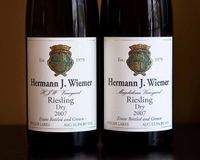By Evan Dawson, Finger Lakes Correspondent
 Some of the best winemakers in the Finger Lakes are now making vineyard-specific wines, providing consumers with more information about what they're drinking, and allowing consumers to compare the different qualities delivered by different sites. Sounds like exactly what the Finger Lakes needs, right?
Some of the best winemakers in the Finger Lakes are now making vineyard-specific wines, providing consumers with more information about what they're drinking, and allowing consumers to compare the different qualities delivered by different sites. Sounds like exactly what the Finger Lakes needs, right?
Well, to a point.
First, the good news: Many of the single-vineyard wines released from the 2007 vintage are intensely distinctive, and they stand as the model for what single-vineyard wines should be. They come from a perspicacious trio, three winemakers who prioritize site selection.
LENNDEVOURS readers already know about our high regard for the Ravines 2007 Argetsinger Vineyard Dry Riesling. Hot on the heels of that wine come a pair of single-vineyard gewurztraminers from Red Newt and a series of single-vineyard rieslings from Hermann Wiemer. If you're interested in magazine scores, it's worth noting that Red Newt's 2007 Sawmill Creek Gewurztraminer cracked the 89-point barrier in Wine Spectator with a score of 90, and the 2007 Curry Creek Gewurztraminer (which winemaker Dave Whiting says will ultimately be a better wine) grabbed 89 points. And I had the chance to not only taste the Wiemer 2007 wines, but winemaker Fred Merwarth tasted me through the 2008s in tank (and still fermenting). I was inspired by how much individuality each wine was already showing.
For Merwarth, this is a natural next step.
"Hermann sought out special places to grow grapes, and we want to show our customers what each site brings to the table," he says, noting that he and Wiemer spent the past decade separating the juice by vineyard in individual tanks. "Magdalena is one of the warmest mesoclimates in the Finger Lakes, and it makes a richer wine than the HJW Vineyard. Magdalena is always going to give you this juicy wine that is balanced with acidity. The HJW is almost cutting with its minerality. We think people will enjoy finding the differences, and it helps them identify which profile they might prefer."
Whiting has been thinking about taking this step for a while at Red Newt.
"I can stand in a vineyard, throw a stone fifty feet, and where it lands will give me an entirely different profile of wine," Whiting says. He's particularly excited about Curry Creek, which might end up with a kind of "Grand Cru" status for Finger Lakes gewurztraminer. "That wine should age really nicely. We think we've found quite a unique place for that grape."
At Ravines, Hallgren offers a cautionary note: "I don't want single-vineyard designation to lose its meaning through dilution," he says. "Right now it's heading in a good direction. Red Newt and Hermann Wiemer do things the right way. But I hope the entire region doesn't see it as a trend to make more money. If people start making single-vineyard wines simply to command a higher price, the concept will be as meaningless as 'reserve' wines. Single-vineyard should mean something. The winemaker should be able to explain to you why the site is special, and what sets it apart."
Merwarth points out that there are almost certainly special sites in the Finger Lakes that have yet to be discovered. "Morten's absolutely right. The search is far from over, but that doesn't mean we should see a bunch more every year. The baseline for a single-vineyard wine has to be a repeatable profile. You've got to know what you expect from that site, cause if it's always changing, there's no reason for your customers to trust you."
Single-vineyard wines offer an exciting glimpse into the intricacies of our sense of place, and that's because the people making them have patiently scoured the region for the best locations. For now, it is a slow-developing trend to be celebrated.
What single-vineyard wines am I missing? What single-vineyard wines have you tried? If you'll excuse me, I'm off to uncork the 2007 Hermann Wiemer Magdalena Dry Riesling and the 2007 Hermann Wiemer HJW Dry Riesling. I can't wait to discover and enjoy the difference over tonight's dinner.
